Advanced Plant Experiment (APEX)
APEX-10 (Plant-Microbe Interactions in Space)
Plant and microbial associations are key to the success of individual plants, but scientists do not yet understand how the space environment may alter these associations. Plant-Microbe Interactions in Space (APEX-10) tests whether the beneficial microbe Trichoderma harzianum confers increased stress resilience and improved growth to seedlings of tomato plants (Lycopersicum esculentum) when the two are grown together in microgravity.
APEX-08 (Advanced Plant EXperiment-08)
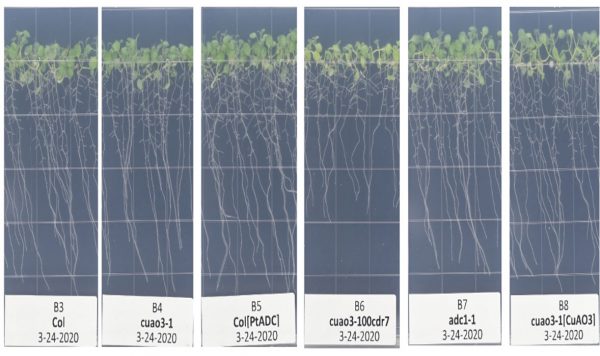 Compounds known as polyamines contribute to plant stress mitigation on Earth, and plants grown in microgravity display evidence of stress at the morphological level and gene-expression changes suggestive of stress response. Advanced Plant EXperiment-08 (APEX-08) examines the role of these compounds in these plant responses to microgravity in Arabidopsis thaliana. Results could provide insights into the mechanisms plants use to modulate the stress of microgravity.
Compounds known as polyamines contribute to plant stress mitigation on Earth, and plants grown in microgravity display evidence of stress at the morphological level and gene-expression changes suggestive of stress response. Advanced Plant EXperiment-08 (APEX-08) examines the role of these compounds in these plant responses to microgravity in Arabidopsis thaliana. Results could provide insights into the mechanisms plants use to modulate the stress of microgravity.
APEX-07 (Advanced Plant EXperiment-07)
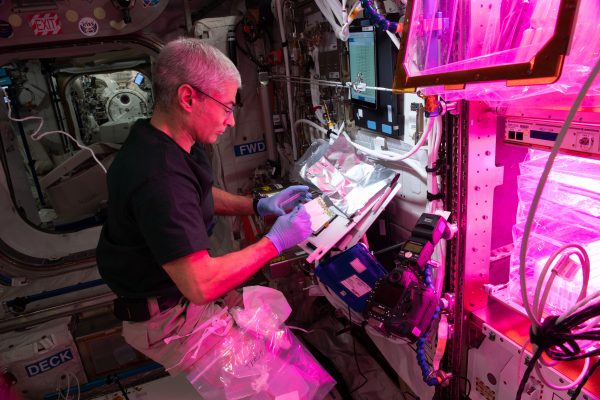 Advanced Plant Experiment-07 (APEX-07) examines how changes in gravity and other environmental factors associated with spaceflight affect plants at the level of gene expression. Previous research shows that microgravity conditions during spaceflight affects which genes turn on or off, which proteins are present and in what amounts, and the modifications made to those proteins. All of these processes are controlled by RNA, and this investigation analyzes the role of RNA regulation on gene expression during spaceflight in both roots and shoots of plants.
Advanced Plant Experiment-07 (APEX-07) examines how changes in gravity and other environmental factors associated with spaceflight affect plants at the level of gene expression. Previous research shows that microgravity conditions during spaceflight affects which genes turn on or off, which proteins are present and in what amounts, and the modifications made to those proteins. All of these processes are controlled by RNA, and this investigation analyzes the role of RNA regulation on gene expression during spaceflight in both roots and shoots of plants.
APEX-06 (Using Brachypodium distachyon to Investigate Monocot Plant Adaptation to Spaceflight)
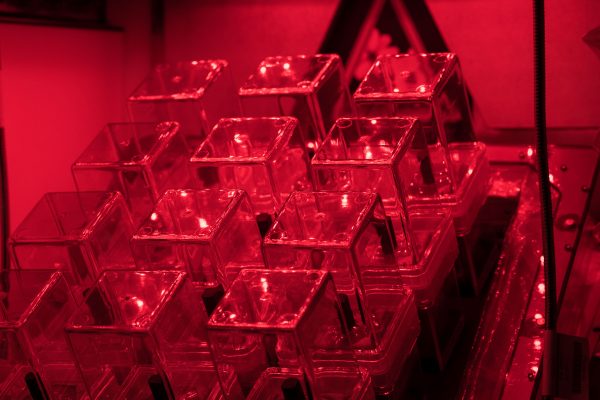 The Using Brachypodium distachyon to Investigate Monocot Plant Adaptation to Spaceflight (APEX-06) experiment investigates the growth of the common grass species Brachypodium distachyon in the microgravity environment of space. The grasses grow from seedlings aboard the International Space Station (ISS), and are returned as frozen samples to Earth-based labs for detailed analysis and comparison with Earth based control groups. APEX-06 aims to compare the growth and gene-expression patterns of Brachypodium distachyon with those of the dicotyledonous model plant Arabidopsis thaliana, which has been extensively studied in space and whose behavior in microgravity is better understood.
The Using Brachypodium distachyon to Investigate Monocot Plant Adaptation to Spaceflight (APEX-06) experiment investigates the growth of the common grass species Brachypodium distachyon in the microgravity environment of space. The grasses grow from seedlings aboard the International Space Station (ISS), and are returned as frozen samples to Earth-based labs for detailed analysis and comparison with Earth based control groups. APEX-06 aims to compare the growth and gene-expression patterns of Brachypodium distachyon with those of the dicotyledonous model plant Arabidopsis thaliana, which has been extensively studied in space and whose behavior in microgravity is better understood.
APEX-05 (Spaceflight-Induced Hypoxic-ROS Signaling)
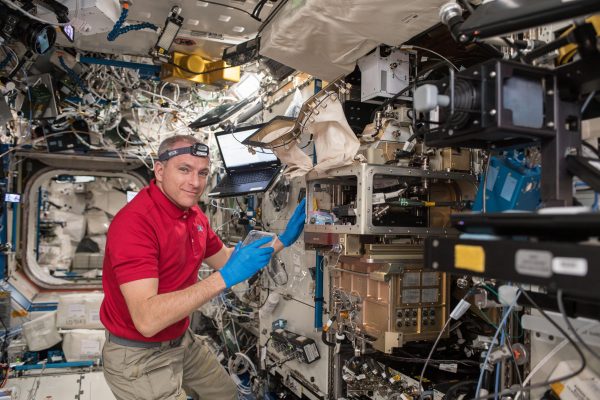 When grown in the confines of the International Space Station (ISS), plants do not seem to get enough air and as a result, exhibit a stress response in their genes and proteins. The Spaceflight-induced Hypoxic/ROS Signaling (APEX-05) experiment grows different wild and mutant varieties of Arabidopsis thaliana, in order to understand how their genetic and molecular stress response systems work in space. The plants grow from seeds in the Veggie plant growth facility aboard the ISS, are frozen, and returned to Earth for detailed laboratory analysis.
When grown in the confines of the International Space Station (ISS), plants do not seem to get enough air and as a result, exhibit a stress response in their genes and proteins. The Spaceflight-induced Hypoxic/ROS Signaling (APEX-05) experiment grows different wild and mutant varieties of Arabidopsis thaliana, in order to understand how their genetic and molecular stress response systems work in space. The plants grow from seeds in the Veggie plant growth facility aboard the ISS, are frozen, and returned to Earth for detailed laboratory analysis.
APEX-04 (Epigenetic change in Arabidopsis thaliana in response to spaceflight – differential cytosine DNA methylation of plants on the ISS)
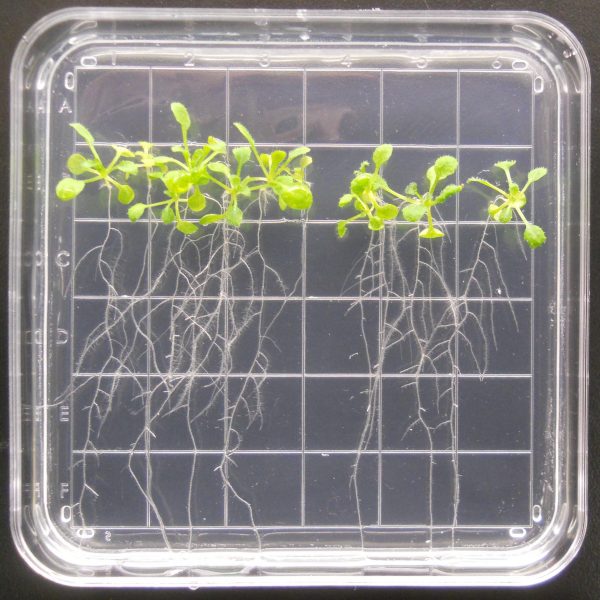 Spaceflight causes several changes to animals and plants, and those that take place on a molecular level can affect how the organism grows without altering its outward appearance. Epigenetic change in Arabidopsis thaliana in response to spaceflight – differential cytosine DNA methylation of plants (APEX-04) studies molecular changes in thale cress seedlings grown in microgravity. Results provide new insight into the molecular biology underlying how plants grow differently in space.
Spaceflight causes several changes to animals and plants, and those that take place on a molecular level can affect how the organism grows without altering its outward appearance. Epigenetic change in Arabidopsis thaliana in response to spaceflight – differential cytosine DNA methylation of plants (APEX-04) studies molecular changes in thale cress seedlings grown in microgravity. Results provide new insight into the molecular biology underlying how plants grow differently in space.
APEX-03-2 TAGES-Isa (Transgenic Arabidopsis Gene Expression System – Intracellular Signaling Architecture)
On Earth, plants use gravity, moisture and light to determine which way to grow, but the microgravity environment of space causes them to develop different growth habits. The Transgenic Arabidopsis Gene Expression System – Intracellular Signaling Architecture (APEX-03-2 TAGES-Isa) investigation studies thale cress (Arabidopsis thaliana) seedlings grown in microgravity, examining the molecular changes that affect their growth. Results provide new insight into how plants respond to extraterrestrial environments, which improves the research for growing food and producing oxygen on future space missions.
APEX-03-1 (Advanced Plant EXperiments-03-1)
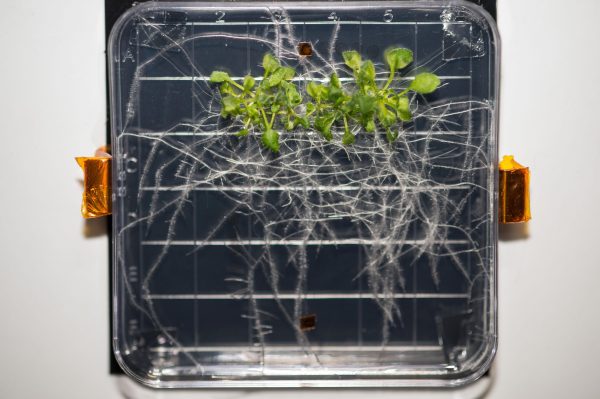 Advanced Plant EXperiments-03-1 (APEX-03-1) continues a highly successful investigation into the effects of microgravity on the development of roots and cells on plant seedlings. The experiment uses the model plant Arabidopsis thaliana, or thale cress, which is grown in Petri plates for a specified duration. After the growth period, the plants are photographed, harvested, and preserved for return to Earth and detailed analysis.
Advanced Plant EXperiments-03-1 (APEX-03-1) continues a highly successful investigation into the effects of microgravity on the development of roots and cells on plant seedlings. The experiment uses the model plant Arabidopsis thaliana, or thale cress, which is grown in Petri plates for a specified duration. After the growth period, the plants are photographed, harvested, and preserved for return to Earth and detailed analysis.
APEX-02-2 (Advanced Plant EXperiments-02-2)
For the Advanced Plant EXperiments-02-2 (APEX-02-2) investigation, a genome-wide series of deletion clones of Saccharomyces cerevisiae, or “Baker’s yeast”, is assayed for radiation damage during spaceflight in comparison to ground controls. On return to Earth, the yeast arrays from space and ground are analyzed by state-of-the-art next generation DNA sequencing techniques. This fresh application of DNA sequencing aims to determine the molecular mechanisms of radiation damage in order to facilitate understanding radiation damage, and may provide simple approaches to enhancing space based and clinical radiation damage.
APEX-CSA2 (Advanced Plant Experiment – Canadian Space Agency 2)
The Advanced Plant Experiment – Canadian Space Agency 2 (APEX-CSA2) investigation examines white spruce, picea glauca, to understand the influence of gravity on plant physiology, growth, and on the genetics of wood formation. It utilizes the Advanced Biological Research System (ABRS) and is the second Canadian botany study to be conducted aboard the International Space Station (ISS).
